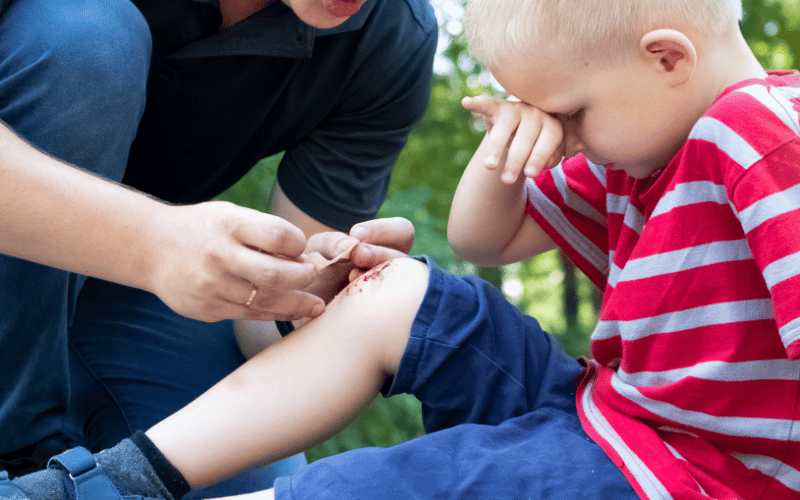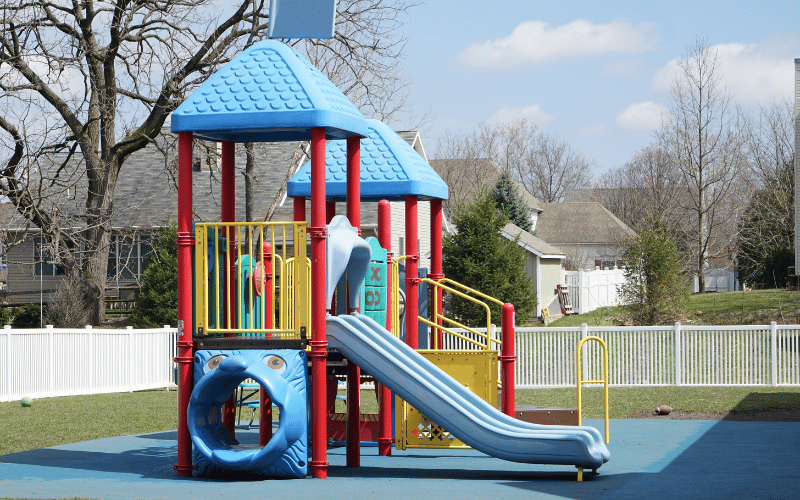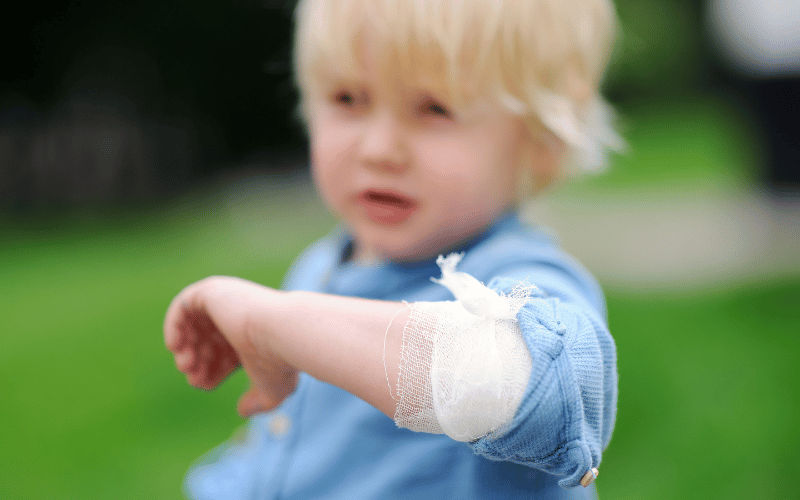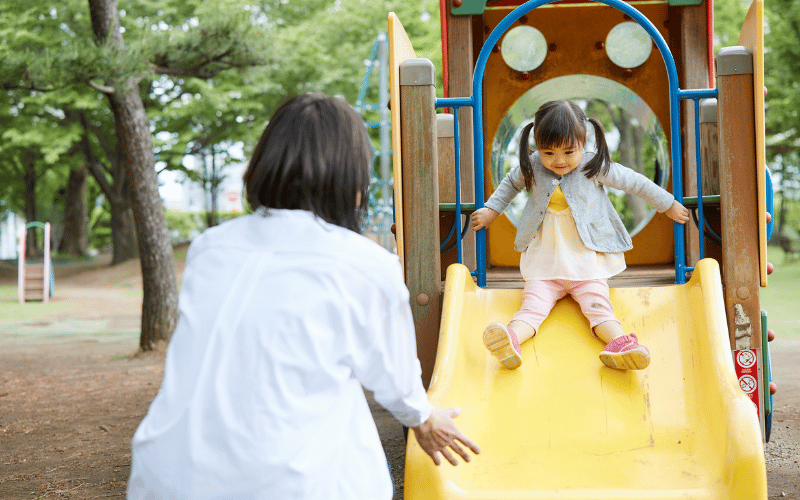Table of Contents
ToggleIntroduction
Playground safety matters because it ensures children can enjoy their playtime without unnecessary risks. Falls, cuts, and fractures rank among the most common playground injuries, but many of these can be prevented with proper supervision, safe equipment, and well-maintained play areas. This guide provides practical tips, expert advice, and actionable steps to create a safer playground environment for every child.
Understanding Playground Hazards
After decades in the outdoor playground equipment industry, I’ve seen playgrounds tell two stories: one of joy and exploration, and another of preventable injuries. Let me guide you through the most common hazards and how to address them with precision and care.
Falls: Causes and Prevention
Falls are the playground’s loudest storyteller, accounting for the majority of injuries. They often occur when surfaces fail to cushion impact or when equipment lacks proper design. To prevent falls, ensure surfacing materials like engineered wood fiber, rubber mulch, or poured-in-place rubber extend at least six feet beyond the equipment’s perimeter. Inspect these surfaces regularly—imagine them as the playground’s safety net, which must remain intact and even. Additionally, choose equipment with guardrails and barriers that match the height and age group of the users. A toddler’s climbing frame should whisper “gentle adventure,” while older kids’ structures should challenge without overwhelming.
Entrapment Risks: Openings, Gaps, and Moving Parts
Entrapment hazards lurk in poorly designed openings and gaps, waiting to snag curious hands or trap small heads. Openings between 3.5 and 9 inches wide are particularly risky, as they can entrap a child’s head. Picture these gaps as silent traps—your job is to eliminate them. Regularly measure and inspect openings in guardrails, barriers, and climbing equipment. Moving parts, like swings or seesaws, should have protective mechanisms to prevent pinching or crushing. Think of these parts as the playground’s moving puzzle pieces—they should fit together seamlessly without catching little fingers.
Strangulation Hazards: Clothing and Ropes
Loose drawstrings, scarves, and ropes can turn into silent threats on the playground. I’ve seen equipment where ropes dangle like inviting vines, only to become dangerous snares. Remove or secure any ropes, cords, or chains that aren’t part of the equipment’s design. Educate caregivers to dress children in snug-fitting clothing without drawstrings. Picture the playground as a stage for safe play—every costume should be free of hazards.
Burns: Hot Equipment in Summer
On a scorching summer day, metal slides and dark-colored surfaces can transform into searing hotplates. I’ve touched equipment that could rival a stovetop, and I’ve seen the burns to prove it. To prevent burns, choose equipment with heat-resistant coatings or lighter colors that reflect sunlight. Install shade structures or plant trees to keep play areas cool. Before play begins, test surfaces with your hand—if it’s too hot for you, it’s too hot for them.
Impact Injuries: Collisions and Sharp Edges
Playgrounds are bustling ecosystems, and collisions are inevitable when children run, climb, and swing. However, you can minimize impact injuries by spacing equipment appropriately. Picture the playground as a dance floor—each piece of equipment needs its own space to move without bumping into others. Inspect for sharp edges or protruding bolts, which can act like hidden daggers. Cover them with protective caps or padding, ensuring every surface invites safe exploration.
By addressing these hazards with care and expertise, you can transform any playground into a haven where children’s laughter reigns and injuries remain a distant memory.

Proactive Safety Measures
Playgrounds are like living, breathing ecosystems, and keeping them safe requires a proactive approach. With the right measures in place, you can ensure every child’s playtime is as secure as it is joyful. Let’s dive into the specifics of how to make that happen.
Playground Inspections: A Parent’s Checklist
Think of a playground as a trusted friend—it needs regular check-ins to stay reliable. Before letting your child loose, take a quick but thorough walk around. Look for loose bolts, rusted chains, or cracked plastic that could pose a risk. Pay attention to surfacing—whether it’s rubber, mulch, or sand, it should be even and free of debris like glass or sharp rocks. Test equipment for stability; a wobbly slide or swing is a red flag. If you spot hazards, report them immediately to the responsible party. Your vigilance is the playground’s best ally.
Safe Attire: Clothing and Footwear Recommendations
Children’s clothing can either be their armor or their Achilles’ heel on the playground. Avoid anything with drawstrings, scarves, or loose straps that could catch on equipment. Shoes should be sturdy and closed-toe—imagine them as the child’s foundation for climbing, running, and jumping. Sandals and flip-flops might seem convenient, but they invite slips and stubbed toes. If the weather calls for layers, ensure jackets fit snugly to prevent snagging. Dressing for play is like gearing up for an adventure—every piece should support safety and movement.
Playground Rules Education: Fun Ways to Teach Safety
Rules don’t have to feel like restrictions; they can be part of the fun. Turn safety lessons into games or stories. For example, create a “superhero safety mission” where kids learn to wait their turn on the slide or avoid walking in front of swings. Use role-playing to demonstrate why certain behaviors, like pushing or climbing outside designated areas, can lead to injuries. Visual aids, like colorful posters or stickers, can reinforce these lessons. When children see rules as part of the play experience, they’re more likely to embrace them.
Effective Supervision: Balancing Freedom and Safety
Supervision is the invisible safety net of any playground visit. Position yourself where you can see the entire play area, but resist the urge to hover. Children need the freedom to explore and test their limits, but your watchful eye ensures they don’t cross into danger. Engage with them—ask about their games, cheer them on, and gently redirect when necessary. Think of yourself as the playground’s narrator, guiding the story without taking over. By striking this balance, you create an environment where kids feel both safe and empowered.
With these proactive measures, you’re not just preventing accidents—you’re fostering a space where children can thrive, explore, and grow with confidence.

Age-Specific Safety Tips
Playgrounds are like storytellers, each piece of equipment designed to match the abilities and imaginations of different age groups. Understanding these differences is key to creating a safe and engaging play environment. Let’s explore how to tailor safety measures to the unique needs of toddlers, preschoolers, and school-age children.
Toddlers (6-23 months): Close Supervision and Low-Height Equipment
Toddlers are explorers at heart, but their unsteady steps and curious hands require extra care. Choose equipment specifically designed for this age group, such as low platforms with ramps or short slides no taller than 32 inches. These pieces act like gentle guides, encouraging exploration without overwhelming their developing skills. Surround these areas with soft surfacing, like rubber mats or sand, to cushion inevitable tumbles. Supervision at this stage should be hands-on—stay within arm’s reach, ready to steady a wobbly climber or redirect a curious crawler. Think of yourself as their safety anchor, allowing them to explore while keeping them grounded.
Preschoolers (2-5 years): Developing Motor Skills Safely
Preschoolers are bursting with energy and eager to test their growing motor skills. They’re ready for slightly more challenging equipment, like small climbing walls, balance beams, and slides up to 4 feet high. These features act as their training ground, helping them build coordination and confidence. Ensure the equipment has guardrails and barriers to prevent falls, and check that all openings are too small to trap heads or limbs. At this age, children are learning to take turns and share, so use playtime to reinforce these social skills. Supervise actively but from a slight distance, giving them room to practice independence while staying close enough to intervene if needed. Picture yourself as their coach, cheering them on while keeping the game safe.
School-Age Children (5-12 years): Encouraging Responsible Play
School-age children are playground veterans, ready to tackle more complex challenges like monkey bars, rope climbers, and taller slides. These features serve as their proving ground, pushing their physical and problem-solving abilities. However, with greater confidence comes the temptation to take risks. Teach them to use equipment as intended—no climbing on top of monkey bars or jumping off swings mid-air. Encourage them to be mindful of younger children sharing the space, fostering a sense of responsibility. Supervision at this stage is more about observation and guidance. Position yourself where you can see the entire playground, stepping in only when necessary. Think of yourself as the quiet guardian, ensuring the playground remains a space for safe adventure.
By tailoring safety measures to each age group, you create a playground that grows with children, meeting their needs at every stage of development. Each piece of equipment becomes a partner in their journey, offering challenges that match their abilities while keeping them safe.
What to Do in Case of an Injury
Even the most carefully designed playgrounds can’t eliminate every scrape or bump. When injuries happen, quick and informed action can make all the difference. Let’s break down the steps to handle these situations effectively, ensuring the playground remains a place of learning and recovery.
First-Aid Basics for Common Injuries
Playgrounds often hand out minor injuries like scrapes, bruises, and the occasional bump. Keep a well-stocked first-aid kit nearby, treating it as your toolbox for quick fixes. For scrapes and cuts, clean the wound with water and apply an adhesive bandage to keep dirt out. If a child takes a tumble and ends up with a bruise, apply a cold pack wrapped in a cloth to reduce swelling—imagine it as a soothing handshake for the injured area. For minor sprains, elevate the limb and use a cold compress to manage swelling until further care is available. Always comfort the child during treatment; your calm demeanor can be as healing as the bandage itself.
When to Seek Medical Attention
Some injuries demand more than a first-aid kit’s capabilities. If a child loses consciousness, complains of severe pain, or shows signs of a broken bone—like swelling, deformity, or inability to move the limb, seek medical attention immediately. Head injuries, even if they seem minor, should be monitored closely for symptoms like dizziness, vomiting, or confusion. Think of these signs as the playground’s way of waving a red flag, urging you to act swiftly. When in doubt, it’s always better to err on the side of caution and consult a healthcare professional.

Reporting Unsafe Playgrounds
An unsafe playground is like a broken promise—it fails to protect the children it’s meant to serve. If you notice hazards like broken equipment, exposed bolts, or inadequate surfacing, report them to the responsible authority immediately. This could be the local parks department, school administration, or property manager. Be specific in your report: describe the issue, its location, and the potential risk it poses. Follow up if necessary to ensure the problem is addressed. By speaking up, you’re not just fixing a piece of equipment—you’re safeguarding the experience for every child who plays there.
Handling injuries and addressing hazards isn’t just about reacting; it’s about creating a culture of safety and care. With the right steps, you can turn even the most challenging moments into opportunities to reinforce the playground’s role as a trusted space for growth and exploration.
FAQs
Playgrounds, like any well-loved space, come with their share of questions. Let’s tackle some of the most common ones with clear, actionable answers to help you keep playtime safe and enjoyable.
What Are the Most Common Playground Injuries?
Playgrounds often hand out injuries like bruises, scrapes, and minor cuts, but the more serious ones—fractures, concussions, and dislocations—tend to result from falls. Falls from climbing equipment or slides are the leading culprits, especially when surfacing fails to cushion the impact. Other common injuries include pinched fingers from moving parts, entrapments in gaps, and burns from overheated equipment. Think of these injuries as the playground’s way of reminding us where attention is needed: proper surfacing, well-maintained equipment, and active supervision.
How Can I Tell if a Playground Surface Is Safe?
The surface beneath a playground is its unsung hero, absorbing the impact of falls and reducing injury risks. To check if it’s doing its job, start with a simple test: kneel down and feel the material. Loose-fill surfaces like wood chips or rubber mulch should be at least 12 inches deep and evenly spread, with no bare spots exposing hard ground. For unitary surfaces like rubber mats or poured-in-place rubber, look for cracks, wear, or hard spots that could compromise their cushioning. Imagine the surface as a safety net—it should feel soft yet firm enough to support play. If it’s compacted, uneven, or thinning, it’s time for maintenance.
What Should I Look for When Inspecting Equipment?
Playground equipment, like a trusted companion, needs regular check-ins to stay reliable. Start by scanning for visible damage: cracks in plastic, rust on metal, or splinters in wood. Pay close attention to bolts and fasteners—are they secure, or are they sticking out like unwelcome guests? Check for sharp edges or protrusions that could cause cuts or snags. Moving parts, like swings or seesaws, should glide smoothly without excessive wear or pinching hazards. Finally, test the stability of larger structures by giving them a gentle shake—if they wobble, they’re not ready for play. Think of your inspection as a conversation with the playground; it will tell you what needs attention if you know where to look.
By addressing these FAQs with care and precision, you’re not just answering questions—you’re equipping yourself to create a safer, more enjoyable playground experience for everyone involved.
Conclusion
Prioritizing key safety principles—like regular inspections, age-appropriate equipment, proper surfacing, and active supervision—creates a playground environment where children can thrive. By addressing hazards and fostering awareness, you ensure every child enjoys safe and joyful play, turning the playground into a space where fun and security go hand in hand.






